The original cinema here was, itself, a partial conversion of the County Hotel, the site of which is marked on the 1876 OS Map and a map of 1846. The present grade B listed building was originally the Caley Picture House, having opened on 1 January 1923 with Game of Life – a silent film. In 1928, the building was enlarged for the new ‘talkies’. Several incarnations since then have included nightclubs and a live music venue – which closed after a farewell party on 31 December 2013.
A plaque documenting the history of The Caley Picture House.

The plaque reads: This former live music venue closed after a farewell party on 31 December 2013.
The grade B listed building was originally The Caley Picture House, which opened on 1 January 1923 with a silent film Game of Life. In 1928, the building was enlarged for the new ‘talkies’, with an imposing entrance block added at the right hand side (31 Lothian Road). The new block, with its large stained-glass window, was converted from a Temperance hotel. The original cinema was a partial conversion of the County Hotel. The site of both hotels is marked on the 1876 OS Map as a single property – The Commercial Hotel and Tavern, which is also recorded on the map of 1846. The last picture show at the Caley was in 1984. The landmark cinema became a nightclub named the Caley Palais, renamed Century 2000 and Revolution. The building later stood empty for several years, until it re-opened in 2008, as The Picture House.
Text about the original Caley Picture House.
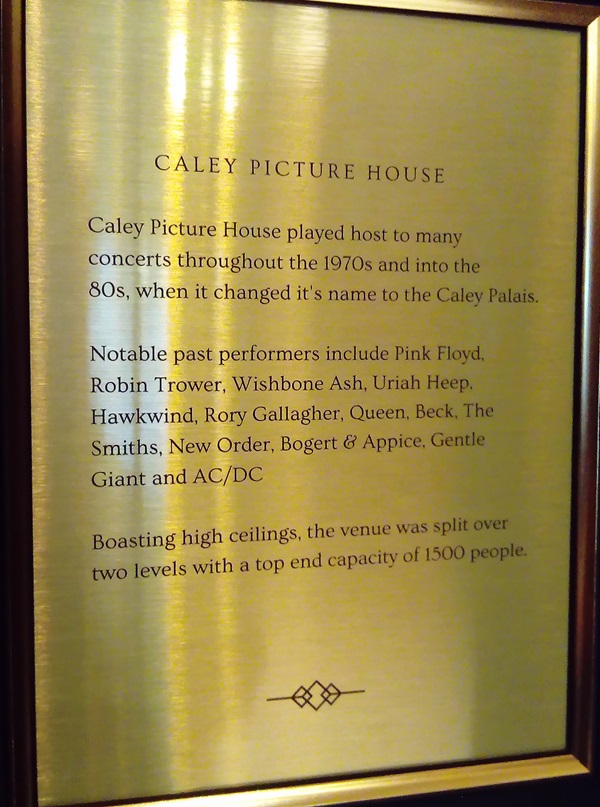
The text reads: Caley Picture House played host to many concerts throughout the 1970s and into the 80s, when it changed its name to Caley Palais.
Notable past performers include Pink Floyd, Robin Trower, Wishbone Ash, Uriah Heep, Hawkwind, Rory Gallagher, Queen, Beck, The Smiths, New Order, Bogert & Appice, Gentle Giant and AC/DC.
Boasting high ceilings, the venue was split over two levels with a top capacity of 1,500 people.
A photograph and text about the history of Castle Street.
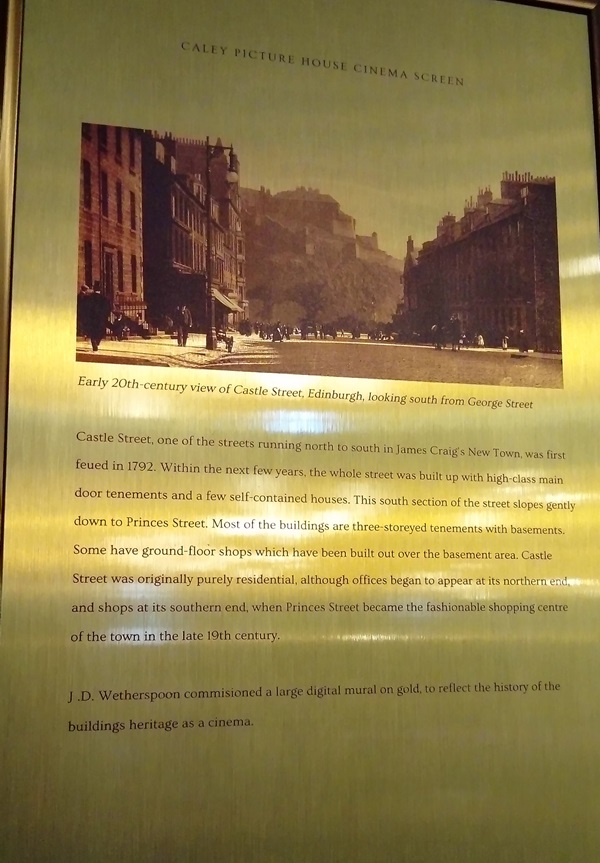
The text reads: Castle Street, one of the streets running north to south in James Craig’s New Town, was first feued in 1792. Within the next few years, the whole street was built up with high class main door tenements and a few self-contained houses. This south section of the street slopes gently down to Princes Street. Most of the buildings are three storeyed tenements with basements. Some have ground floor shops which have been built over the basement area. Caste Street was originally purely residential, although offices began to appear at its northern end, and shops at the southern end, when Princes Street became the fashionable shopping centre of the town in the late 19th century.
Above: Early 20th century view of Castle Street, Edinburgh, looking south from George Street.
A print and text about Art Deco cinemas.
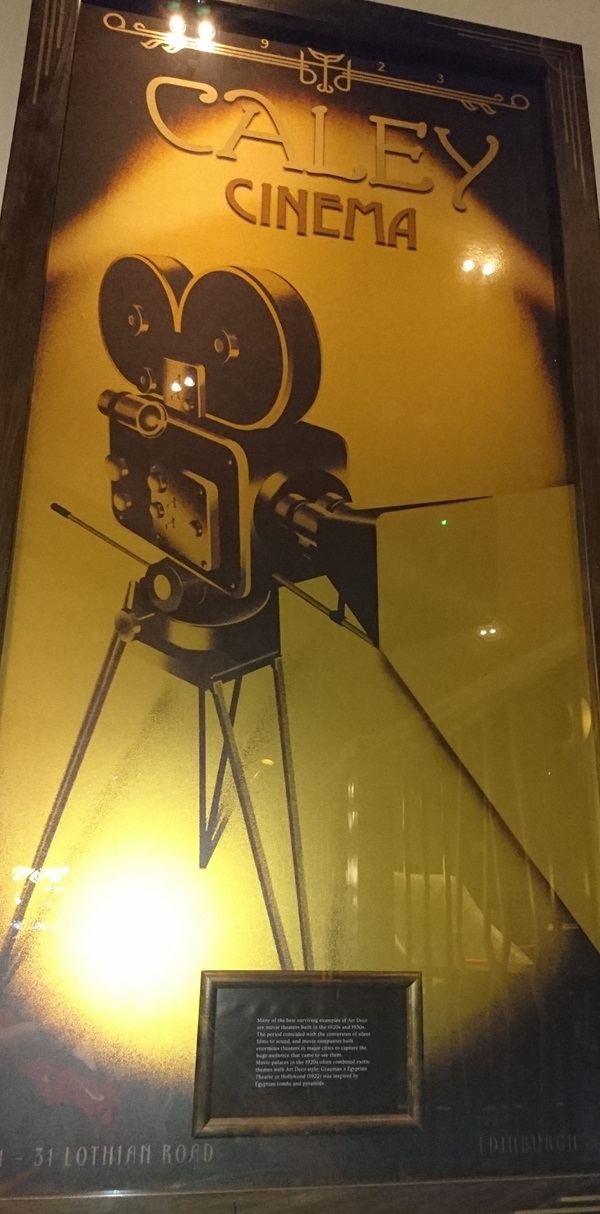
The text reads: Many of the best examples of Art Deco are movie theatres built in the 1920s and 30s. The period coincided with the conversion of silent films to sound, and movie companies built enormous theatres in major cities to capture the huge audience that came to see them. Movie palaces in the 1920s often combined exotic themes with Art Deco style; Grauman’s Egyptian Theatre in Hollywood (1922) was inspired by Egyptian tombs and pyramids.
Text about the history of The Caley Picture House.

The text reads: The Caley Picture House was a cinema and concert venue located in Edinburgh, Scotland. The auditorium, which opened in 1923, originally seated 900. Later increasing to 1,900 in 1928.
The cinema was closed in 1984 and was converted into a discotheque in 1986. Past performers include Robin Trower, Wishbone Ash, Uriah Heep, Hawkwind, Rory Gallagher, Queen, Beck, Bogert & Appice, Gentle Giant and AC/DC.
An architectural illustration of Caley Picture House, Edinburgh, 1923.

Text about the Art Deco architecture in the building.
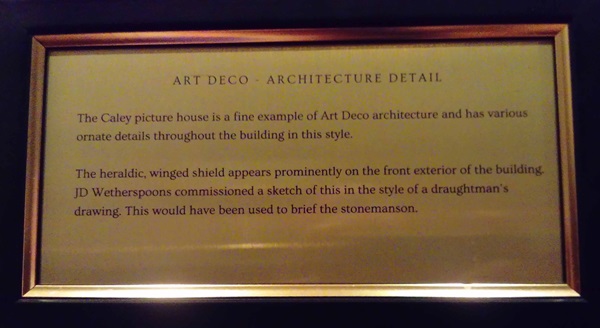
The text reads: The Caley Picture House is a fine example of Art Deco architecture and has various ornate details throughout the building in this style.
The heraldic, winged shield appears prominently on the front exterior of the building. J D Wetherspoon commissioned a sketch of this in the style of a draughtsman’s drawing. This would have been used to brief the stonemason.
Text about Art Deco architecture in cinema.
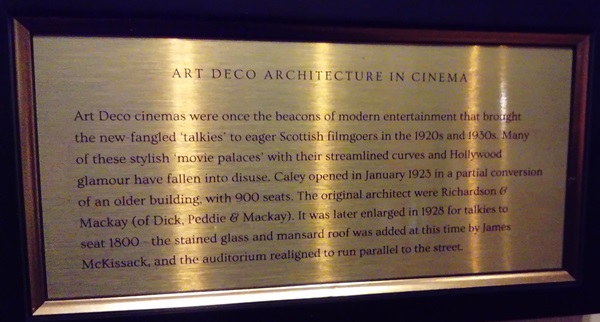
The text reads: Art Deco cinemas were once the beacons of entertainment that brought the new-fangled ‘talkies’ to eager Scottish filmgoers in the 1920s and 30s. Many of these stylish movie palaces, with their streamlined curves and Hollywood glamour, have fallen into disuse. Caley opened in January 1923 in a partial conversion of an older building, with 900 seats. The original architects were Richardson and Mackay (of Dick, Peddie & Mackay). It was later enlarged in 1928 for talkies to seat 1,800 – the stained-glass and mansard roof was added at this time by James McKissack, and the auditorium realigned to run parallel to the street.
Text about the patterns used in Art Deco.

The text reads: Art Deco is a style of visual arts, architecture and design that became popular in the 1920s and 30s, influencing the design of buildings, furniture, fashion, cinemas, trains and ocean liners. Taking its name from Arts Decoratifs, this popular style combined a modernist style with fine craftsmanship and rich materials.
Art Deco was a pastiche of many different styles, sometimes contradictory, united by a desire to be modern. From its outset, Art Deco was influenced by the bold geometric forms of Cubism. The geometry of Art Deco inspired a collection of original illustrations commissioned by J D Wetherspoon for The Caley Picture House.
A photograph of the south west view of Lothian Road, before the construction of the Caley Cinema, Edinburgh, c1920.

A photograph of north west of Lothian Road after the building of Caley Picture House, c1923.

A photograph of Caley Picture House on Lothian Road, Edinburgh, showing The Leopard Woman with Louisa Glaum, c1923.

Internal photographs showing some of the original Art Deco cinema design features.
.jpg?h=416&&w=600&la=en&hash=4098AAA21212F9FEAE6290170A69DA9F8E4D661A)
.jpg?h=404&&w=600&la=en&hash=585304117A0E541F57847CB63421D5AC04D5DF0E)
.jpg?h=422&&w=600&la=en&hash=17C60B859669CFEC789B0F2531F9A0767FF03B74)
.jpg?h=433&&w=600&la=en&hash=222C8B1862F810ACCBC96C8631AF6E355136A903)
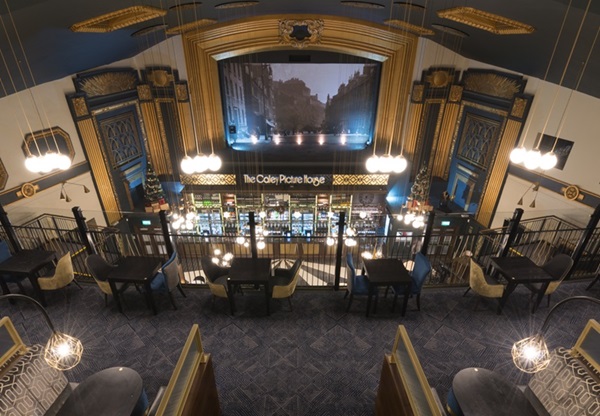
External photograph of the building – main entrance.
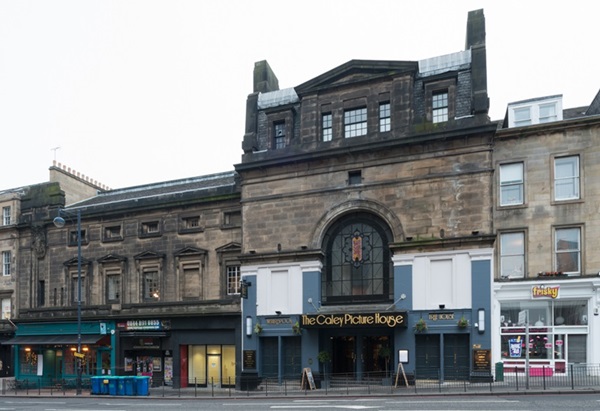

If you have information on the history of this pub, then we’d like you to share it with us. Please e-mail all information to: pubhistories@jdwetherspoon.co.uk